Dialogflow simplifies creating a chatbot with various Google capabilities. Including pre-built ML Models that may help you get started right away in less time than if you were to construct one from scratch.
You can also interface your conversational agent with well-known platforms like Twitter, Telegram, Facebook Messenger, Google Assistant, and more using Dialogflow.
To include the agent in websites, it also offers Web API.
According to a recent study by Gartner, Dialogflow is the most popular conversational AI platform.
So, let's dive in and discover how Dialogflow can transform your business communication!
What is Dialogflow?
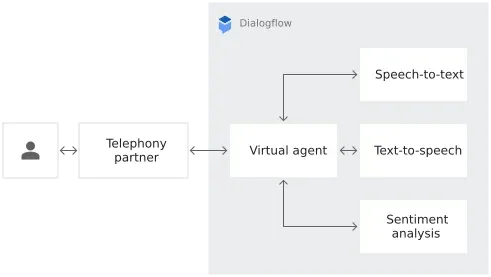
Dialogflow is a cutting-edge platform developed by Google that allows businesses to create conversational agents.
These agents can understand and respond to natural language, enabling more interactive and personalized customer communication.
With Dialogflow, you can create powerful chatbots and voice bots that can understand customer queries, provide information, and even perform tasks.
How Dialogflow Works?
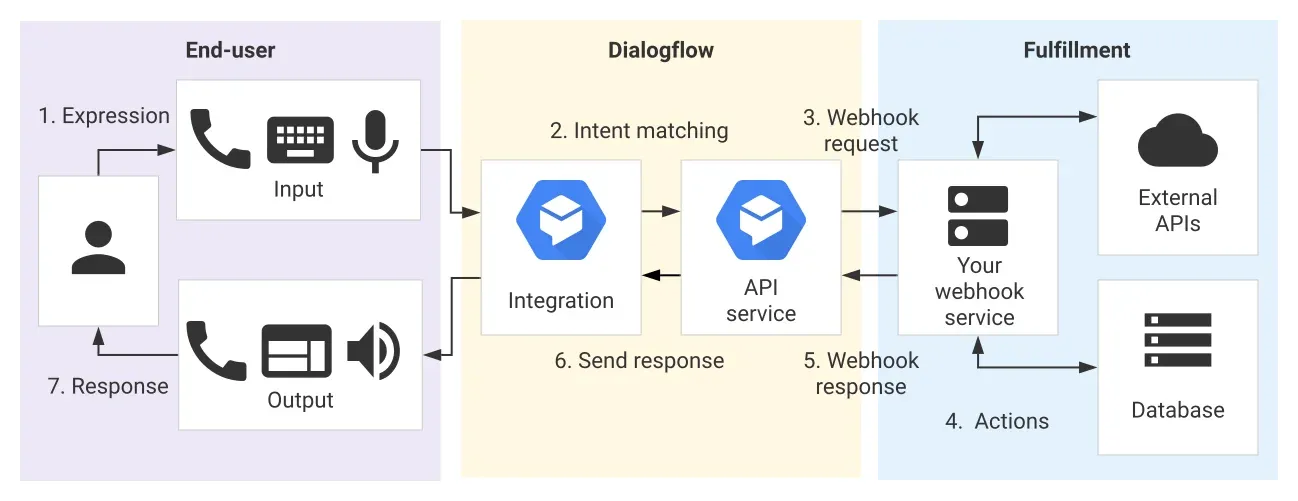
Dialogflow utilizes machine learning techniques to process and understand user inputs.
When a user interacts with a conversational agent, Dialogflow analyzes the text or speech and extracts the user's intent, entities, and other relevant information.
It then determines the appropriate response based on predefined rules, conditions, or custom logic.
Different Types of Conversational Agents Available on Dialogflow
Dialogflow offers different conversational agents to cater to various business needs.
- Text-based Chatbots: These agents are designed for text-based interactions on websites, messaging apps, and social media platforms.
- Voice Bots: With voice bots, businesses can provide conversational experiences through voice-enabled devices like smart speakers and virtual assistants.
- Interactive Voice Response (IVR) Systems: Dialogflow also supports IVR systems, enabling businesses to automate phone-based interactions and provide self-service options to customers.
How to Create a Dialogflow Agent?
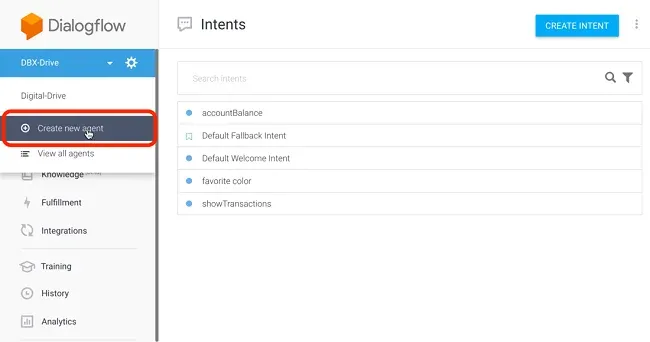
Now that we have a good understanding of what Dialogflow is, let's explore the step-by-step process of creating a Dialogflow agent.
- Set up a Dialogflow Account: Visit the Dialogflow website and sign in using your Google account. Create a new project to get started.
- Create an Agent: Within your project, create a new agent. Give it a name and other optional details to help identify it.
- Define Intents: Intents represent the various actions or queries that users can perform. You'll define and map different intents to corresponding user expressions or utterances.
- Define Entities: Entities are contextual pieces of information that your agent can extract from user input. Define entities based on the specific information relevant to your use case.
- Define Contexts: Contexts help Dialogflow understand the conversation flow and remember previous interactions. Define contexts to tailor the responses based on the conversation context.
- Train and Test: After defining intents, entities, and contexts, it's time to train your agent and test its performance. Dialogflow provides easy-to-use testing tools to ensure your agent understands and responds accurately.
How to Train a Dialogflow Agent?
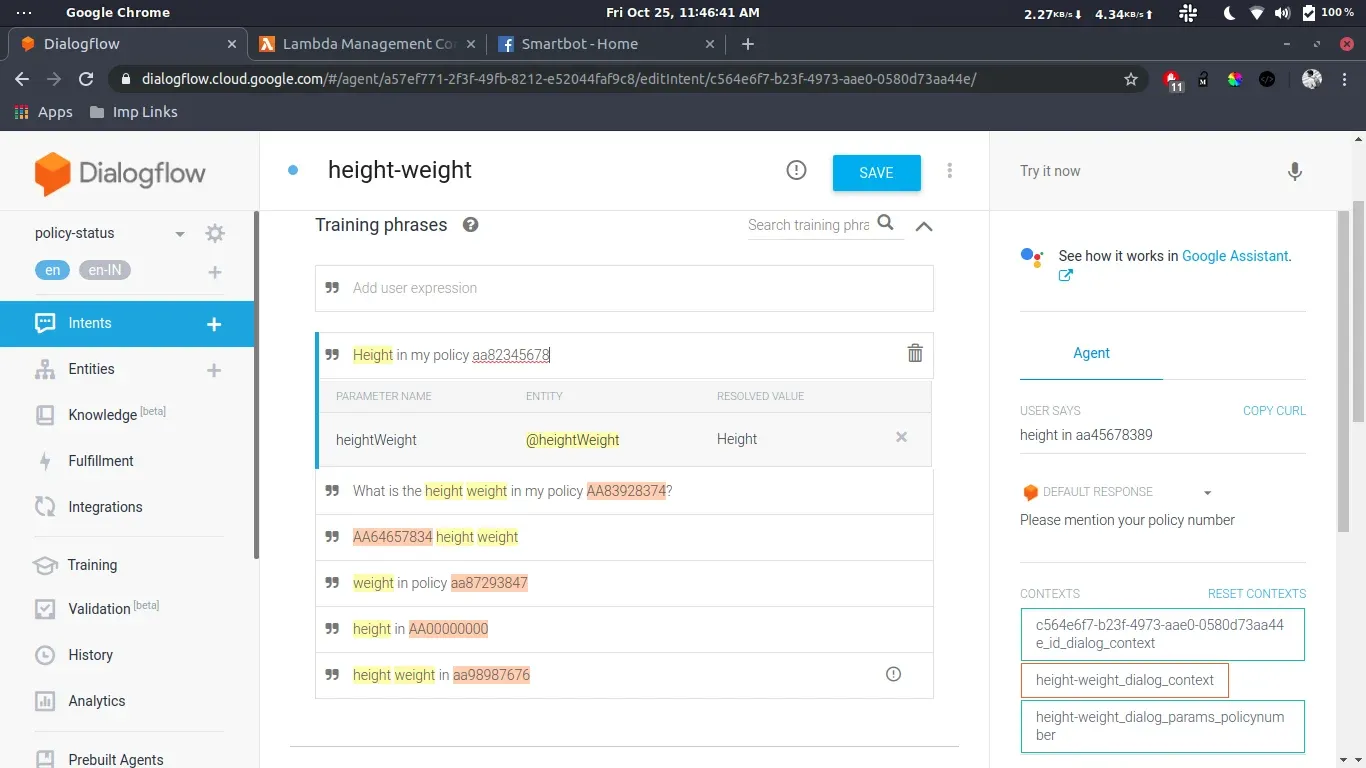
Training a Dialogflow agent is crucial in creating an effective conversational AI solution. In this section, we'll explore the training process for a Dialogflow agent, different ways to train it and share some tips for effective agent training.
Training Process for a Dialogflow Agent
When you create a Dialogflow agent, it starts with a blank slate. It needs to gain knowledge and understanding of user queries. That's where training comes in. The training process involves providing examples, called training phrases or utterances, to help the agent understand how users express a specific intent.
Dialogflow uses natural language understanding (NLU) algorithms to analyze and learn from these training phrases.
It also considers the predefined intent definitions, entity mappings, and context settings to create a model that can accurately interpret user inputs and generate appropriate responses.
Different Ways to Train a Dialogflow Agent
Dialogflow provides multiple ways to train your agent, ensuring it understands a wide range of user expressions and intents.
- Entities Mapping
Entities are crucial for extracting important information from user queries. Dialogflow allows you to define entities and map them to specific values or synonyms. By mapping entities, you can teach your agent to recognize and extract relevant information from user inputs accurately.
- Reviewing Logs
Reviewing the logs of user interactions with your agent can provide valuable insights into areas where your agent may require additional training. Analyzing user inputs, correct and incorrect responses, and any missed intents can help you identify patterns and improve your agent's performance.
Suggested Reading:
Creating and Managing Intents on Dialogflow
Intents are the backbone of a Dialogflow agent. They represent the different actions or queries users can make.
In this section, we'll explore the importance of intents and guide you on creating and managing them effectively on Dialogflow.
Intents and Their Importance in Dialogflow
Intents define the purpose or goal of a user's input. They help Dialogflow understand what the user wants and determine the appropriate response. By accurately defining and managing intents, you can ensure your agent provides relevant and contextual responses.
How to Create and Manage Intents on Dialogflow?
Creating and managing intents on Dialogflow is straightforward. Here's a step-by-step guide:
- Define Intents: Identify the different actions or queries your agent needs to handle. Create a new intent for each action/query and provide a name and training phrases that represent user expressions for that intent.
- Configure Responses: Once an intent is defined, configure the responses that your agent should provide when that intent is detected. Responses can be text, rich messages, or even fulfillment actions.
- Enable Webhook or Fulfillment: If your agent needs to perform certain tasks or retrieve information from external sources, enable a webhook or fulfillment. This allows your agent to interact with external services and provide dynamic responses.
How to Create and Manage Contexts on Dialogflow?
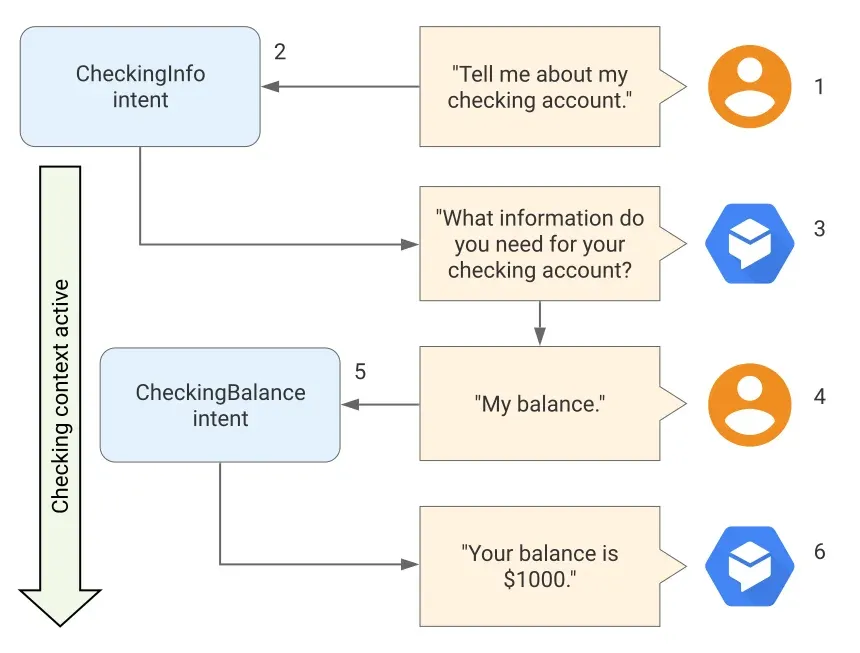
Contexts are important in maintaining conversational flow and providing relevant responses.
In this section, we'll explore the concept of contexts and their importance in Dialogflow and guide you on creating and managing them effectively.
Contexts and Their Importance in Dialogflow
Contexts are a way to track and remember information during a conversation. They help Dialogflow understand the context of user inputs based on previous interactions, enabling more accurate and contextually relevant responses.
How to Create and Manage Contexts on Dialogflow?
Creating and managing contexts on Dialogflow is essential to maintain the conversational flow. Here's how you can do it:
- Define Contexts: Identify the important information that must be carried forward during a conversation. Create the corresponding contexts and assign them to the appropriate intents.
- Set Input and Output Contexts: Input contexts specify the conditions for an intent to be matched, while output contexts determine which contexts are set or cleared based on an intent. Define input and output contexts to control the flow of the conversation.
- Use Lifespan: Each context has a lifespan specifying how long it should remain active. Set the appropriate lifespan to ensure the context remains active when needed and is cleared when no longer relevant.
Suggested Reading:
How to Create and Manage Contexts on Dialogflow?
Contexts are vital in creating seamless conversational experiences for users and providing relevant responses.
In this section, we'll dive into what contexts are why they're important in Dialogflow and guide you through creating and managing them effectively.
Explanation of Contexts and Their Importance in Dialogflow
Contexts are a way to track and remember information during a conversation. They help Dialogflow understand the context of user inputs based on previous interactions.
Using contexts, you can pick up a conversation where you left off in a previous interaction and provide more accurate, contextually relevant responses.
Contexts have two main types - input and output. Input contexts specify the conditions for an intent to be matched, while output contexts determine which contexts are set or cleared based on intent.
Using contexts can help your Dialogflow agent:
- Maintain conversational flow
- Provide relevant responses
- Use previous information to personalize responses
- Better understanding of user inputs
How to Create and Manage Contexts on Dialogflow?
Creating and managing contexts on Dialogflow is essential to maintaining a seamless conversation. Here's how you can do it:
- Define Contexts: Identify the information that needs to be carried forward during a conversation. Create the corresponding contexts and assign them to the appropriate intents.
- Set Input and Output Contexts: Input contexts specify the conditions for an intent to be matched, while output contexts determine which contexts are set or cleared based on an intent. Define input and output contexts to control the flow of the conversation.
- Use Lifespan: Each context has a lifespan specifying how long it should remain active. Set the appropriate lifespan to ensure the context remains active when needed and is cleared when no longer relevant.
How to Integrate Dialogflow with Other Platforms?
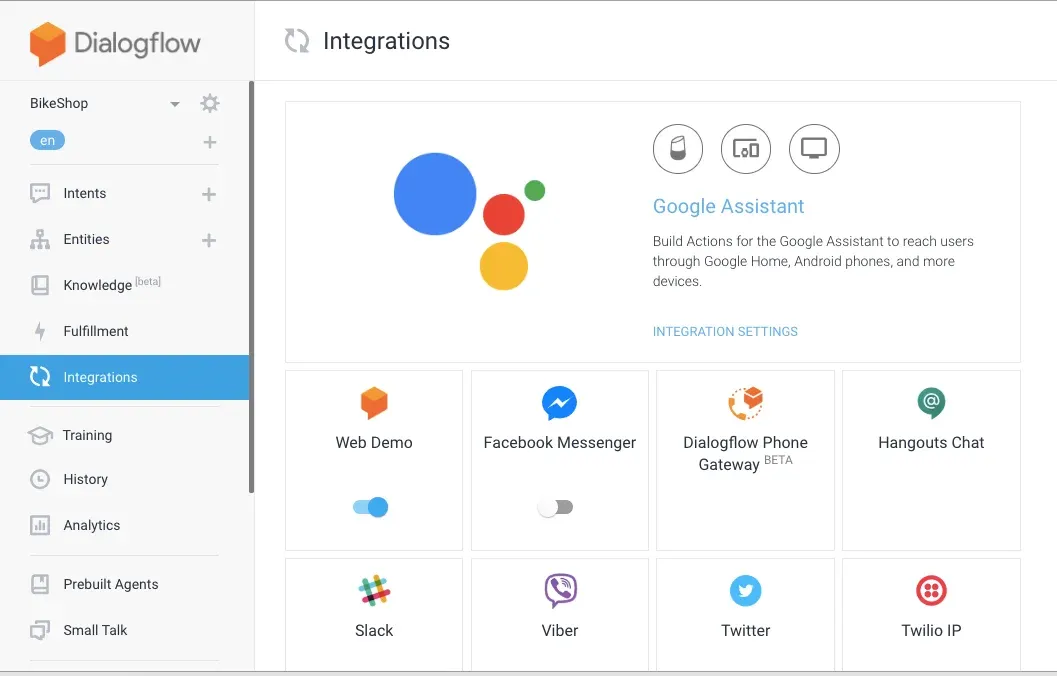
Integrating Dialogflow with other platforms like Google Assistant and Slack is an effective way to reach more users and provide them with better conversational experiences.
In this section, we'll explore the importance of integration and guide you through integrating Dialogflow with other platforms.
The Importance of Integrating Dialogflow with Other Platforms
Integrating Dialogflow with other platforms can help you:
- Reach more users on different channels
- Provide 24/7 support
- Scale your conversational experience
- Personalize responses based on user data from external platforms
Different Ways to Integrate Dialogflow with Other Platforms
Dialogflow offers several ways to integrate with other platforms. You can explore some options:
- Google Assistant: Integrate your Dialogflow agent with Google Assistant to reach users on Google Home, Android phones, and other devices.
- Slack: Set up a bot in Slack and use the Dialogflow API to integrate your agent with the messaging platform.
- API Integration: Use Dialogflow's APIs to integrate with other platforms and services.
Best Practices for Using Dialogflow
Designing effective conversational experiences for users is crucial in creating a successful Dialogflow agent.
This section will share some best practices for using Dialogflow and tips for adopting conversational design strategies.
Advice for Adopting Conversational Design Best Practices
To adopt conversational design best practices, consider the following advice:
- Use Natural Language: Use natural language that users are familiar with to create a more relatable, conversational experience.
- Personalize Responses: Use user data to personalize responses and create a more tailored experience.
- Empathize with Users: Empathize with users and anticipate their needs to create a helpful and supportive experience.
Dialogflow Essentials for Developers
If you're a developer looking to master Dialogflow, you've come to the right place!
In this section, we'll cover the essential information you need to get started with Dialogflow and build powerful conversational experiences.
Understanding the Dialogflow API, Client Libraries, and SDKs
Dialogflow offers a robust API that allows developers to interact with their agents programmatically.
This API enables you to send user queries, receive responses, manage contexts, and more. It's the backbone of Dialogflow development and provides endless possibilities for customization.
Dialogflow also offers client libraries and SDKs in various programming languages such as Python, JavaScript, Java, and more to make your life as a developer easier.
These libraries provide convenient wrappers around the API, making integrating Dialogflow into your applications simpler.
Whether you prefer to use the Dialogflow API directly or leverage client libraries and SDKs, you can choose the approach that best suits your development workflow.
Exploring Dialogflow Developer Resources
As a developer, you may have a natural inclination to dive into documentation and code samples to learn a new platform. Luckily, Dialogflow provides many resources to help you on your journey.
The Dialogflow documentation explains features, concepts, and best practices. It's the go-to resource for understanding the ins and outs of Dialogflow.
If you're a developer who loves learning by doing, Dialogflow offers interactive code labs where you can follow step-by-step instructions to create your first conversational agent. These code labs provide hands-on experience and help solidify your understanding of Dialogflow.
Additionally, the Dialogflow community is vibrant and supportive. You can join the Dialogflow Google Group or the Reddit community to connect with other developers, ask questions, and share your experiences.
Conclusion
Starting your journey with Dialogflow is the first step towards creating exceptional conversational experiences. Armed with the knowledge of the Dialogflow API, client libraries, and SDKs, you're well-equipped to dive into development.
Feel free to begin creating and training your agents immediately. The possibilities are endless, and the impact of Dialogflow in the age of conversational AI is immense.
So go ahead, unleash your creativity, and let Dialogflow be the key to unlocking powerful conversational interactions for your users. Happy coding!
Suggested Reading:
Frequently Asked Questions (FAQs)
What is Dialogflow, and how can I get started today?
Dialogflow is a conversational AI platform that allows you to build chatbots and virtual assistants. To start with Dialogflow today, you can sign up for an account, create an agent, and start designing conversations and adding intents.
Is Dialogflow suitable for beginners with no coding experience?
Yes, Dialogflow is beginner-friendly and does not require coding experience. It offers a visual interface for building chatbot interactions and provides pre-built templates and integrations to simplify creating conversational agents.
What are the different integration options available with Dialogflow?
Dialogflow offers various integration options, including integration with websites, messaging platforms like Facebook Messenger and Slack, voice assistants like Google Assistant and Amazon Alexa, and custom integrations using APIs.
Does Dialogflow support multiple languages?
Dialogflow supports multiple languages, including English, Spanish, French, German, and more. You can build chatbots and virtual assistants in different languages to cater to a global or multilingual audience.
Can Dialogflow handle complex conversations and user inputs?
Dialogflow is capable of handling complex conversations and user inputs. It uses natural language understanding and machine learning to interpret user queries and provide accurate, context-aware responses.

